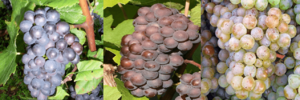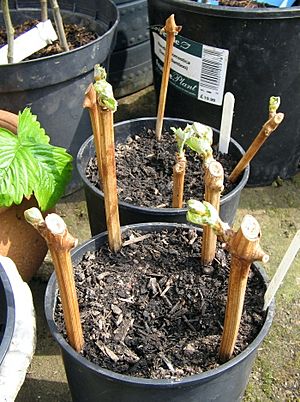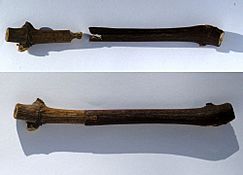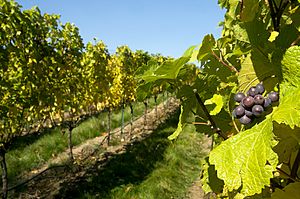Propagation of grapevines facts for kids
The propagation of grapevines is super important for growing grapes, whether for eating or making wine. Most grapevines belong to the Vitis vinifera family. They produce grapes every year, but individual vines don't live forever. While some vines can live for over a hundred years, most are replaced after 10 to 30 years.
When vineyard owners want to plant new vines, they have several cool ways to do it. They can plant a new cutting from an existing vine, which is like taking a piece of a plant and growing a whole new one from it. They can also graft a new plant onto the roots of an older vine. Another method is layering, where a branch from an existing vine is buried in the ground to grow its own roots.
It's rare for commercial vineyards to grow grapevines from seedlings. That's because each seed has unique genetic information from its two parent vines. So, a vine grown from a seed would be a completely new variety, different from its parents! Even if two Chardonnay vines cross-pollinate, the seeds from their grapes would grow into new, distinct varieties, not Chardonnay. That's why growers usually use cuttings to keep the same grape variety. However, grape breeders use seeds to create exciting new grape varieties. This includes crossings (like Cabernet Sauvignon, which is a mix of Cabernet Franc and Sauvignon blanc) or hybrid grape varieties (like Baco blanc, which comes from Vitis vinifera and Vitis labrusca species).
Contents
Understanding Grapevine Reproduction
What is a Color Mutation?
A color mutation happens when a grape variety changes slightly, usually in color, but is still very similar to its original parent. It's considered unique enough to be called its own variety. For example, both Pinot gris and Pinot blanc are color mutations of Pinot noir. They are genetically almost the same, but their grape colors are different.
What is a Clone?
In grape growing, a clone is an exact copy of a single grapevine, called a "mother vine." Growers might choose a specific mother vine because it has great qualities, like producing lots of grapes, resisting diseases, or having small, flavorful berries. They then take cuttings from this mother vine to create many identical clones. Grapes like Sangiovese and Pinot noir are known for having many different clones, each with slightly different traits. Even with small differences, all clones are still considered part of the same grape variety.
What is Selection Massale?
Selection massale is the opposite of cloning. Instead of picking one perfect vine, growers choose cuttings from many different vines across their vineyard. This helps keep a mix of different traits from the whole group of vines.
What is a Crossing?
A crossing is a brand new grape variety created when two different varieties of the *same* grape species cross-pollinate. For example, Syrah is a crossing of two French Vitis vinifera grapes: Dureza and Mondeuse blanche. Interestingly, every seedling (a vine grown from a seed), even if its parents are the same grape variety, is technically a crossing. This is because the new vine from the seed will be genetically different from its parents.
What is a Hybrid?
A hybrid is a new grape variety made by cross-pollinating two different *species* of grapes. Early in the history of American winemaking, growers mixed European Vitis vinifera vines with American vines like Vitis labrusca. They did this to create "French-American hybrids" that could better resist American grape diseases, such as downy and powdery mildew, and a tiny insect called phylloxera. When the phylloxera epidemic hit Europe in the 1800s, some European growers tried using these hybrids. Eventually, a better solution was found: grafting European vines onto American rootstocks. The use of hybrids in wine production then became less common.
How Grapevines are Propagated
Since winemakers want specific grape varieties that reliably produce good crops, most grapevines are grown using cuttings from selected vines. This can be done in three main ways.
Growing from Cuttings
This method involves taking a shoot (a young branch) from a "mother vine." This shoot is then planted, and it will eventually grow its own root system and become a full vine with a trunk and canopy. Often, these new cuttings are first planted in a special nursery. They stay there for a couple of years to grow strong roots before being moved to the vineyard.
Grafting New Vines
Grafting is a process where a new grapevine is created by joining two different plant parts. It involves making a cut in the rootstock (the root system of an existing vine) and attaching a piece of a new vine, called a scionwood. This new piece is sealed onto the rootstock. Sometimes, the top part of an old vine is removed and replaced with a cutting from a new vine.
There are two main types of grafting for grapevines:
Bench Grafting
This type of grafting is usually done indoors in a greenhouse during late winter or early spring. It's used for younger, smaller vines before they are planted in the vineyard. The way the cuts are made determines the type of bench graft.
- The Omega Graft is done by cutting the rootstock and the scion (the new vine piece) into matching shapes that fit together like puzzle pieces.
- The Whip Graft involves making identical small, angled cuts on both the rootstock and the scion so they can be joined smoothly.
Field Grafting
Field grafting is done directly in the vineyard after a vine has been planted and grown for a few years. The main reason for this method is to avoid having to replant an entire vine. It allows growers to change the grape variety of an existing vine. This is done by making cuts in the rootstock of a planted vine and inserting scions of a different grape type.
Common ways to do field grafting include:
- The Chip Bud Method is done shortly after a grapevine is planted, when the rootstock is active but the new bud is still dormant. Small slopes are cut into the rootstock, and a small scion bud is placed into these cuts.
- The T Bud Method involves making a T-shaped cut at the bottom of the grapevine, just above the soil. The bark around the cut is gently pulled back, and the scion is placed inside.
- The Cleft Graft is performed on the branches of a grapevine when the rootstock is dormant. A wedge-shaped cut is made in the rootstock, and two scions are placed into it. Once the graft starts growing, one of the scions is removed, leaving only one to grow.
- The Bark Graft involves making three cuts on the edge of the grapevine's rootstock. Most of the bark around each cut is removed, leaving a small piece at the end. Three scions are then inserted into these cuts, and the remaining bark covers the ends of the scions.
Layering New Vines
In vineyards where only a few vines need to be replaced (perhaps due to damage or disease), layering is a simple way to grow new ones. A cane (a long branch) from a nearby healthy vine is bent down into the ground and covered with dirt. This buried part of the vine will soon start to grow its own independent root system, while still getting nutrients from the original vine. After the new vine develops strong roots, the connection to the original vine is cut, allowing both vines to grow on their own.
Clonal vs. Massal Selection
Every cutting taken from a mother vine is a clone, meaning it's an exact copy. How a grower chooses these cuttings is called either clonal or massal selection.
In clonal selection, a single, ideal plant in a vineyard or nursery that shows the best qualities is chosen. All the cuttings are taken from this one plant.
In massal (or "mass") selection, cuttings are taken from several vines of the same variety that, as a group, show good qualities.
Historically, massal selection was the main way vineyards were propagated, especially in older vineyards where vines were replaced one by one using layering. In the 1950s, people started identifying and isolating specific, desirable clones in nurseries. This led to more clonal selection, with new vineyards often planting clones from famous, well-established vineyards.
However, some experts have raised concerns about "mono-clonal" viticulture (using only one clone). They worry it might lead to wines that are too similar and less interesting. Another concern is that vineyards might lose their genetic diversity if only a few clones are used. Also, what was considered a "desirable trait" in the past (like early ripening or high grape yields) might not be as important today. Now, traits like low yields or being able to resist drought might be more valued.







